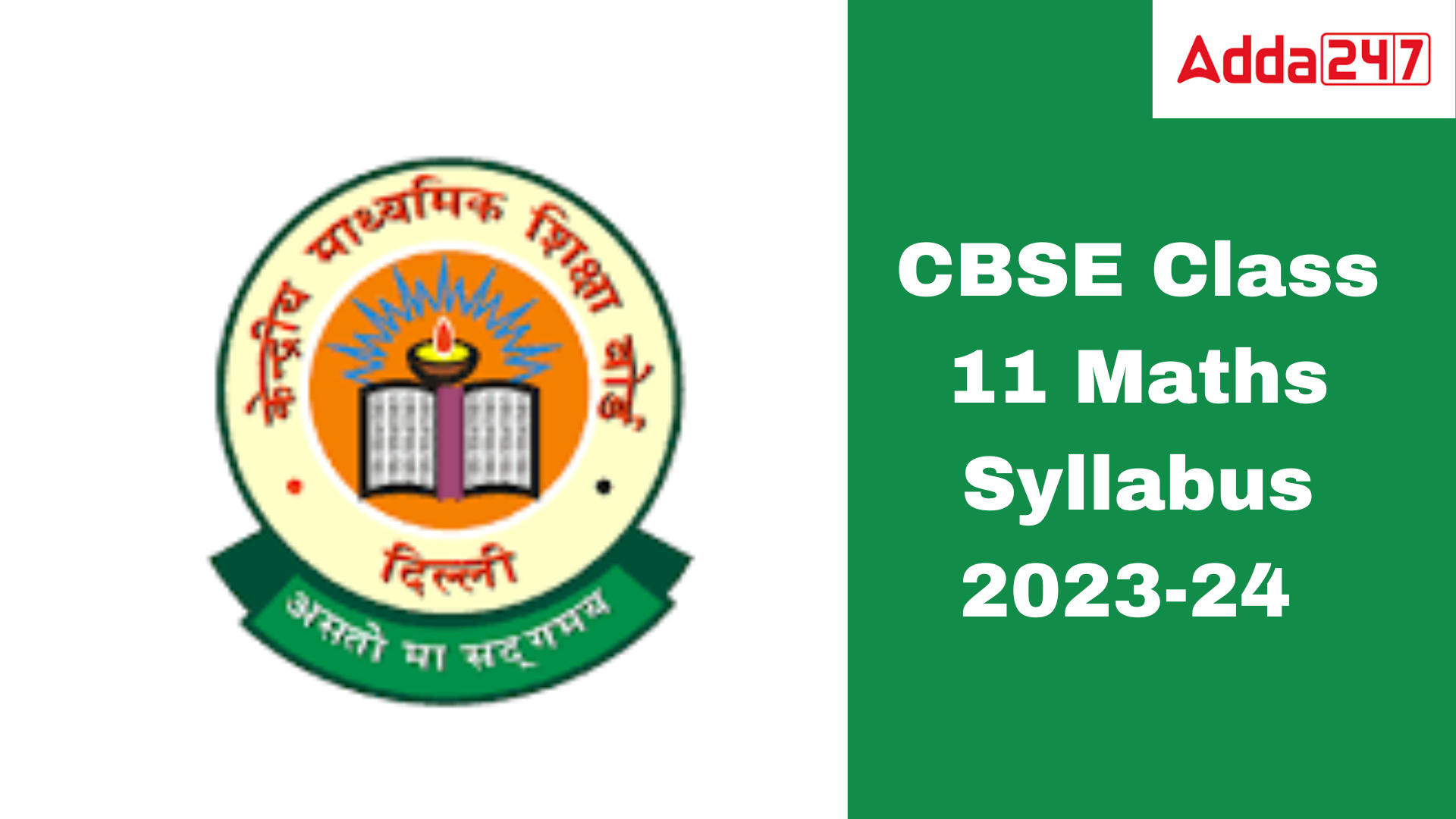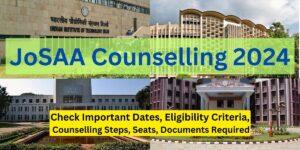Table of Contents
CBSE Class 11 Maths Syllabus 2023-24: The Central Board of Secondary Education (CBSE) has already published the 2023-2024 Mathematics (subject code 041) curriculum for Class 11th students. Students can review the course structure, comprehensive unit-wise syllabus contents, and question paper design of the paper and download the CBSE Class 11 Maths Syllabus 2023-24 PDF straight from this article.
CBSE Class 11 Maths Syllabus 2023-24
The following topics are covered in the CBSE Class 11 Mathematics Syllabus for 2023-2024:Sets: The essential notions of sets, such as sets, subsets, and unions, are introduced in this section. Relations and Functions: The ideas of relations and functions are covered in this unit.Straight Lines: This unit is concerned with straight lines in two dimensions.
Conic Sections: This unit is about conic sections like the circle, ellipse, parabola, and hyperbola.Trigonometry: This unit studies trigonometric functions including sine, cosine, and tangent.Trigonometry Applications: This unit looks at how trigonometry can be used to solve issues involving triangles and circles.Vectors: This unit is concerned with vectors, such as vector addition, subtraction, and multiplication.Statistics: This area is concerned with data gathering, presentation, and analysis.Probability: This unit covers probability concepts such as random experiments and expected values.
CBSE Class 11 Maths Syllabus 2023-24 Course structure
The table below consists of the course structure of the CBSE Class 11 Maths syllabus 2023-24.
| No. | Units | Marks |
| I | Sets and Functions | 23 |
| II | Algebra | 25 |
| III | Coordinate Geometry | 12 |
| IV | Calculus | 08 |
| V | Statistics and Probability | 12 |
| Total | 80 | |
| Internal Assessment | 20 |
CBSE Class 11 Maths Syllabus 2023-24 Question paper design
The table consists of question paper design of CBSE Class 11 maths syllabus 2023-24
| Typology of Questions | Total Marks | % Weightage |
| Remembering: Exhibit memory of previously learned material by recalling facts, terms, basic concepts, and answers.
Understanding: Demonstrate understanding of facts and ideas by organizing, comparing, translating, interpreting, giving descriptions, and stating main ideas. |
44 | 55 |
| Applying: Solve problems in new situations by applying acquired knowledge, facts, techniques, and rules in a different way. | 20 | 25 |
| Analyzing: Examine and break information into parts by identifying motives or causes. Make inferences and find evidence to support generalizations.
Evaluating: Present and defend opinions by making judgments about information, validity of ideas, or quality of work based on a set of criteria. Creating: Compile information together in a different way by combining elements in a new pattern or proposing alternative solutions. |
16 | 20 |
| TOTAL | 80 | 100 |
CBSE Class 11 Maths Syllabus 2023-24 Unit-wise syllabus
The table below consists of CBSE Class 11 Maths syllabus 2023-24.
| Unit | Name | Description |
| 1 | Sets and Functions | 1. Sets
Sets and their representations, Empty sets, Finite and Infinite sets, Equal sets, Subsets, and Subsets of a set of real numbers especially intervals (with notations). Universal set. Venn diagrams. Union and Intersection of sets. Difference of sets. Complement of a set. Properties of Complement. 2. Relations & Functions Ordered pairs. Cartesian product of sets. A number of elements in the Cartesian product of two finite sets. Cartesian product of the set of reals with itself (up to R x R x R).Definition of relation, pictorial diagrams, domain, co-domain and range of a relation. Function as a special type of relation. Pictorial representation of a function, domain, co-domain and range of a function. Real valued functions, domain and range of these functions, constant, identity, polynomial, rational, modulus, signum, exponential, logarithmic and greatest integer functions, with their graphs. Sum, difference, product and quotients of functions. 3. Trigonometric Functions Positive and negative angles. Measuring angles in radians and degrees and conversion from one measure to another. Definition of trigonometric functions with the help of unit circle. The truth of the identity sin2x + cos2x = 1, for all x. Signs of trigonometric functions. Domain and range of trigonometric functions and their graphs. Expressing sin (x±y) and cos (x±y) in terms of sex, siny, cost & cosy and their simple applications. |
| 2 | Algebra | 1. Complex Numbers and Quadratic Equations
Need for complex numbers, especially √−1, to be motivated by the inability to solve some of the quadratic equations. Algebraic properties of complex numbers. Argand plane 2. Linear Inequalities Linear inequalities. Algebraic solutions of linear inequalities in one variable and their representation on the number line. 3. Permutations and CombinationsThe fundamental principle of counting. Factorial n. (n!) Permutations and combinations, derivation of Formulae for nPr and nCr and their connections, simple applications. 4. Binomial Theorem Historical perspective, statement and proof of the binomial theorem for positive integral indices. Pascal’s triangle, simple applications. 5. Sequence and Series Sequence and Series. Arithmetic Mean (A.M.) Geometric Progression (G.P.), general term of a G.P., the sum of n terms of a G.P., infinite G.P. and its sum, geometric mean (G.M.), the relation between A.M. and G.M. |
| 3 | Coordinate Geometry | 1. Straight Lines
Brief recall of two-dimensional geometry from earlier classes. The slope of a line and angle between two lines. Various forms of equations of a line: parallel to axis, point-slope form, slope-intercept form, two-point form, intercept form, and Distance of a point from a line. 2. Conic Sections Sections of a cone: circles, ellipse, parabolas, hyperbolas, a point, a straight lines and a pair of intersecting lines as a degenerated case of a conic section. Standard equations and simple properties of parabola, ellipse and hyperbola. Standard equation of a circle. 3. Introduction to Three-dimensional Geometry Coordinate axes and coordinate planes in three dimensions. Coordinates of a point. Distance between two points. |
| 4 | Calculus | 1. Limits and Derivatives
Derivative introduced as rate of change both as that of distance function and geometrically. The intuitive idea of limit. Limits of polynomials and rational functions trigonometric, exponential and logarithmic functions. The definition of derivative relates it to slope of the tangent of the curve, a derivative of the sum, difference, product and quotient of functions. Derivatives of polynomial and trigonometric functions. |
| 5 | Statistics and Probability | 1. Statistics
Measures of Dispersion: Range, Mean deviation, variance and standard deviation of ungrouped/grouped data. 2. Probability Events; occurrence of events, ‘not’, ‘and’ and ‘or’ events, exhaustive events, mutually exclusive events, Axiomatic (set theoretic) probability, connections with other theories of earlier classes. Probability of an event, probability of ‘not’, ‘and’ and ‘or’ events. |
CBSE Class 11 Maths Syllabus 2023-24 PDF
The CBSE Class 11 Mathematics Syllabus is intended to assist students build a solid understanding of basic mathematical topics. Download CBSE Class 11 Maths Syllabus 2023-24 PDF by Clicking The Below Link.
CBSE Class 12 Maths Syllabus 2023-24
Also check ,


 NEET Admit Card 2024 Release Date, Check...
NEET Admit Card 2024 Release Date, Check...
 Plus One Result 2024 Date, Kerala DHSE +...
Plus One Result 2024 Date, Kerala DHSE +...
 JoSAA Counselling 2024- Check Registrati...
JoSAA Counselling 2024- Check Registrati...















